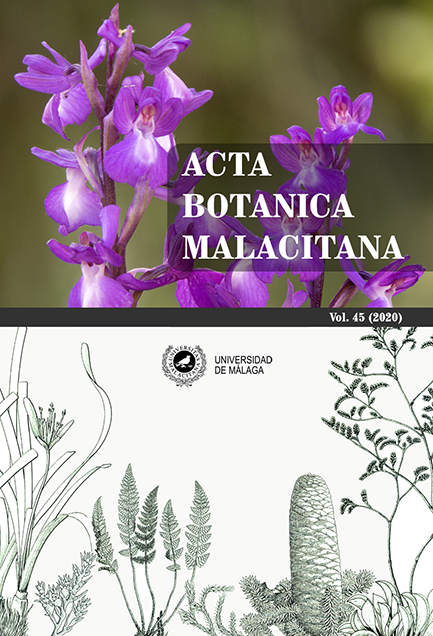Teucrium chlorocephalum ?elak. (= T. reverchonii Willk.), a poor known andalusian endemism: Distribution and conservation
DOI:
https://doi.org/10.24310/abm.v45i.10154Keywords:
Teucrium, endemism, Malaga, Iberian Peninsula, conservationAbstract
Teucrium chlorocephalum ?elak. (= T. reverchonii Willk.), is an Andalusian ende-mism repeatedly confused with T. haenseleri Boiss. In this work, the known distribution of this species is updated based on herbarium vouchers, its only currently known populations are disclosed, and its conservation status is evaluated.
Downloads
Metrics
References
ANTHOS (2020). Sistema de información de las plantas de España. Real Jardín Botánico, CSIC - Fundación Biodiversidad.
Boissier, P. E. (1839–1845). Voyage botanique dans le Midi de L´Espagne pendant l'Année 1838, vol. 2. París.
Cabezudo, B., Nieto Caldera, J.M., Navarro, T. (1991). Cátalogo de las labiadas (Labiatae) malacitanas (Málaga, España). Acta Botanica Malacitana, 16 (2), 347-371.
?elakovský, L. (1883). Ueber einige Arten der Gattung Teucrium. Botanisches Zentralblatt, 14, 186–188.
Cueto, M., Melendo, M., Giménez, E., Fuentes, J., López, E., Blanca, G. (2018). First updated checklist of the vascular flora of Andalusia (S of Spain), one of the main biodiversity centres in the Mediterranean Basin. Phytotaxa, 339, 1-95.
Devesa, J.A. (1986). Teucrium haenseleri Boiss., T. reverchonii Willk. y T. algarbiense (Coutinho) Coutinho en Andalucía occidental. Lagascalia, 14 (1), 85–87.
Gavira, O. & Pérez Latorre, A.V. (2005). Aportaciones al catálogo florístico del Valle del Genal. Acta Botanica Malacitana, 30, 197–209.
Gavira-Romero, O., Hevilla-Ordoñez, S. & Cano-García, E. (2016). Aportaciones a la flora de Sierra Alpujata y Sierra Blanca (Coín, Málaga). Botanica Complutensis, 40, 75-102
GBIF (2020). Global Biodiversity Information Facilities. www. GBIF. org.
Govaerts RA, Paton A, Harvey Y, Navarro T, Del Rosario Garcia Pena M (2020). World Checklist of Lamiaceae. Facilitated by the Royal Botanic Gardens, Kew. Published on the Internet; http://wcsp.science.kew.org/ September 2020.
Gutiérrez, L., Fuentes, J., Cueto, M. & Blanca, G. (2019). Top ten de las plantas más amenazadas de Andalucía Oriental: taxones endémicos y no endémicos. Acta Botanica Malacitana, 44, 5–33.
Laza Palacios, M. (1946). Estudios sobre la flora y la vegetación de las Sierras Tejeda y Almijara. Boletín Instituto Botánico Cavanilles 6 (2): 217–370.
López González, G. (1975). Contribución al estudio florístico y fitosociológico de la Sierra de Aguas. Acta Botanica Malacitana, 1, 81–205.
López González, G. (1980). Notas críticas a la flora malacitana. Anales Jardín Botánico Madrid, 36, 275–289.
Navarro, T. (1995). Revisión del género Teucrium L., sección Polium (Mill.) Schreb., en la Península Ibérica y Baleares. Acta Botanica Malacitana, 20, 173–265.
Navarro, T. (2010). Teucrium L. In R. Morales, A. Quintanar, F. Cabezas, A.J. Pujadas & S. Cirujano -eds.- Flora Iberica: Verbenaceae-Labiatae-Callitrichaceae, vol.12 (pp. 30–166). Real Jardín Botánico. CSIC. Madrid.
Pérez-Latorre A.V., Caballero, G., Casimiro-Soriguer, F., Gavira, O. & Cabezudo, B. (2008). Vegetación del sector Malacitano-Axarquiense (Comarca de la Axarquía, Montes de Málaga y Corredor de Colmenar). Málaga (España). Acta Botanica Malacitana, 33, 215–270.
Pérez-Latorre A.V., Casimiro-Soriguer, F., Gavira, O. & Cabezudo, B. (2012). Vegetación de la Reserva de la Biosfera Sierra de las Nieves: Río Grande y Sierras Prieta y Blanquilla (Málaga, España). Acta Botanica Malacitana, 37, 103–140.
Pérez-Latorre, A.V., Hidalgo-Triana, N., Casimiro-Soriguer, F. & Cabezudo, B. (2013). Flora y vegetación serpentinícola Ibérica: Sierra de Alpujata y de la Robla (Málaga, España). Lagascalia, 33, 43–74.
Pérez-Latorre, A.V., Hidalgo-Triana, N. & Cabezudo, B. (2013). Composition, ecology and conservation of the south-Iberian serpentine flora in the context of the Mediterranean basin. Anales Jardín Botánico Madrid, 70(1), 62–71.
Pérez-Latorre, A.V. & Hidalgo-Triana, N. (2017). Los serpentinófitos suribéricos. Las joyas botánicas de Sierra Bermeja. Revista Takurunna, 6–7, 111–112.
Pérez-Latorre, A.V., Hidalgo-Triana, N. & Cabezudo, B. (2018). New data on the southern Iberian serpentinophyte flora (Andalusia, Spain). Mediterranean Botany, 39 (2), 151–155.
Rivas Goday, S. & S. Rivas-Martínez (1969). Matorrales y tomillares de la Península Ibérica comprendidos en la clase Ononido-Rosmarinetea. Anales Instituto Botánico Cavanilles, 25, 7–201.
Rivas-Goday, S. (1973). Plantas serpentinícolas y dolomitícolas del Sur de España. Boletín Sociedad Broteriana, 47 (24 serie), 161–178.
Rivas Martínez, S., Izco, J. & Costa, M. 1973. Asplenium cuneifolium Viv. (A. serpentini Tausch.) en Sierra Bermeja (Málaga). Trabajos Departamento Botánica y Fisiología Vegetal, 6, 23–30.
Rivas Martínez, S. (1978). De plantis hispaniae notulae systematicae, chorologicae et ecologicae III. Anales Instituto Botánico Cavanilles, 34 (2), 539-552.
Ruíz de la Torre, J. (1974). Teucria malagueños de hojas verticiladas. Boletín Estación Central de Ecología, 3(5), 83–95.
Thiers, B. (2020). Index Herbariorum: A global directory of public herbaria and associated staff.
New York Botanical Garden’s Virtual Herbarium. http://sweetgum.nybg.org/ih/.
Willkomm, M. (1891). Ueber neue und kritische Pflanzen der spanisch-portugiesischen und balearischen Flora. Oesterreichische botanische Zeitschrift, 41(1), 51–54.
Downloads
Published
How to Cite
Issue
Section
License
Those authors who publish in this journal accept the following terms:
a. The authors will retain their copyrights and guarantee the journal the right of first publication of their work, which will be simultaneously subject to the Creative Commons Attribution-Non-commercial 4.0 license whose full text can be found at <http: // creative commons .org / licenses / by-nc / 4.0> that allows third parties to share the work as long as its author and its first publication are indicated, and as long as it is not for commercial purposes.
b. Authors may adopt other non-exclusive licensing agreements for the distribution of the version of the published paper (e.g., deposit it in an institutional telematic file or publish it in a monographic volume) provided that the initial publication in this journal be indicated.
c. Authors are allowed and recommended to disseminate their work through the Internet (e.g., in institutional telematic archives or on their websites) before and during the submission process, which can produce interesting exchanges and increase citations of the published work. (See The effect of open access)







1.png)
